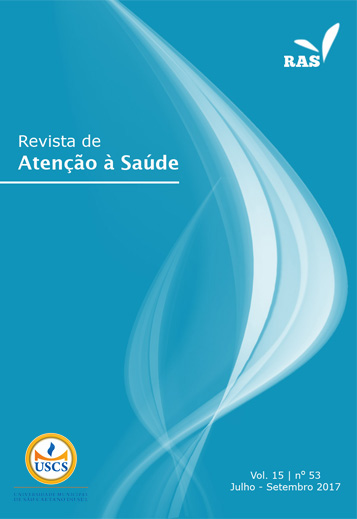LEISURE-TIME PHYSICAL INACTIVITY IN UNDERGRADUATE STUDENTS OF PHYSICAL EDUCATION FROM BAHIA, BRAZIL
DOI:
https://doi.org/10.13037/ras.vol15n53.4735Keywords:
Risk behavior, students, physical education, leisure activitiesAbstract
Introduction: Physical inactivity is one of the main risk factors related to worldwide mortality, with great implications for chronic diseases. In relation to university students, physical inactivity represents a prevalent behavior. Objective: To estimate the prevalence and factors associated with leisure-time physical inactivity in university students of a Physical Education course. Methodology: It is a cross-sectional study carried out in a public higher education institution from state of Bahia. The physical inactivity investigated by Prevalence Ratio (PR). Significance level was 5%. Results: 111 university students participated in it. The prevalence of physical inactivity in leisure-time was 14.4%. Female students were associated with leisure-time physical inactivity (PR: 6.22; CI95%: 1.62 – 23.90), university students of higher age groups were less inactive in leisure-time when compared to younger ones (PR: 0.18; 95%CI: 0.04 – 0.92), and married students were more inactive in leisure-time. Conclusion: The prevalence of physical inactivity in the leisure-time was lower in Physical Education students. Married female students aged between 18 to 20 years old had higher prevalence of leisure-time physical inactivity.
Downloads
References
World Health Organization. Global recommendations on physical activity for health. Geneva: WHO; 2010. 58 p.
Kohl HW, Craig CL, Lambert EV, Inoue S, Alkandari JR, Leetongin G, et al. The pandemic of physical inactivity: global action for public health. Lancet. 2012;380(9838):294-305.
Bueno DR, Marucci MFN, Codogno JS, Roediger MA. Os custos da inatividade física no mundo: estudo de revisão. Cien Saude Colet. 2016;21(4):1001-10.
Hallal PC, Victora CG, Wells JCK, Lima RC. Physical inactivity: prevalence and associated variables in Brazilian adults. Med Sci Sports Exerc. 2003;35(11):1894-900.
Brasil. Ministério da Saúde. Secretaria de Vigilância em Saúde. Secretaria de Gestão Estratégica e Participativa. Vigitel Brasil 2012: vigilância de fatores de risco e proteção para doenças crônicas por inquérito. Brasília, DF: Ministério da Saúde; 2012.
Siqueira FV, Facchini LA, Piccini RX, Tomasi E, Thumé E, Silveira DS, et al. Atividade física em adultos e idosos residentes em áreas de abrangência de unidades básicas de saúde de municípios das regiões Sul e Nordeste do Brasil. Cad Saude Publica. 2008;24(1):39-54.
Alves JGB, Siqueira FV, Figueiroa JN, Facchini LA, Silveira DS, Piccini RX, et al. Prevalência de adultos e idosos insuficientemente ativos moradores em áreas de unidades básicas de saúde com e sem Programa Saúde da Família em Pernambuco, Brasil. Cad Saude Publica. 2010;26(3):543-56.
World Health Organization. World health statistics 2008. Geneva: WHO; 2008. 110 p.
Sousa TF. Inatividade física em universitários brasileiros: uma revisão sistemática. Rev Bras Ciên Saúde. 2011;29(9):47-55.
Bielemann RM, Karine G, Azevedo MR, Reichert FF. Prática de atividade física no lazer entre acadêmicos de educação física e fatores associados. Rev Bras Ativ Fís Saúde. 2007;12:(3)65-72.
Mielke GI, Ramis TR, Habeyche EC, Oliz MM, Tessmer MGS, Azevedo MR, et al. Atividade física e fatores associados em universitários do primeiro ano da Universidade Federal de Pelotas. Rev Bras Ativ Fís Saúde. 2010;15(1):57-64.
Santos TS, Leão OAA, Leite JS, Silva MC. Atividade física em acadêmicos de educação física: um estudo longitudinal. Rev Bras Ativ Fís Saúde. 2017;22(1):76-84.
Sousa TF, Santos SFS, Pie ACS, Rossato LC. Associação entre indicadores de prática de atividades físicas na adolescência com o nível atual de prática de atividades físicas no lazer em acadêmicos de um curso de educação física no Nordeste do Brasil. Pensar Prát. 2009;12(3):1-12.
World Health Organization. World Health Report 2002: reducing risks, promoting healthy life. Geneva: WHO; 2002. 250 p.
World Health Organization. Obesity: preventing and managing the global epidemic: report of a WHO consulation of obesity. Geneva: WHO; 1997. 252p.
Resende MA, Resende RBV, Tavares RS, Santos CRR, Barreto-Filho JAS. Estudo comparativo do perfil pró-aterosclerótico de estudantes de medicina e educação física. Arq Bras Cardiol. 2010;95(1):1-9.
Santos SFS, Freitas Junior IF, Alvarenga AM, Fonseca SA, Virtuoso Junior JS, Sousa TF. Prevalence and factors associated with leisure-time physical activity: survey repeated in university students. Rev Bras Cineantropom Hum. 2016;18(5):577-90.
Sousa TF, José HPM, Barbosa AR. Condutas negativas à saúde em estudantes universitários brasileiros. Cienc Saude Colet. 2013;18(12):3563-75.
Del Duca GF, Nahas MV, Garcia LMT, Peres MA. Como gênero e escolaridade interagem nos padrões de inatividade física em diferentes domínios em adultos? Rev. Bras. Educ. Fís. Esporte. 2015;29(4):653-61.
Pazin J, Duarte MFS, Borgatto AF, Peres MA, Poeta LS. Atividade física no lazer, deslocamento, apoio social e percepção do ambiente urbano em homens e mulheres de Florianópolis/SC. Rev. Bras. Educ. Fís. Esporte. 2016;30(3):743-55.
Palma A, Abreu RA, Cunha CA. Comportamento de risco e vulnerabilidade entre estudantes de educação física. Rev Bras Epidemiol. 2007;10(1):117-26.
Monteiro CA, Conde WL, Matsudo SM, Matsudo VR. Bonseñor IM, Lotufo PA. A descriptive epidemiology of leisure-time physical activity in Brazil, 1996-1997. Rev Panam Salud Publica. 2003;14(4):246-54.
Gonçalves H, Hallal PC, Amorim TC, Araújo CLP, Menezes AMB. Fatores socioculturais e nível de atividade física no início da adolescência. Rev Panam Salud Publica. 2007;22(4):256-53.
Sousa TF, Barbosa AR. Validade das medidas referidas da massa corporal e estatura em universitários. ABCS Health Sci. 2016;41(2):71-7.
Downloads
Published
Issue
Section
License
Policy Proposal for Journals offering Free Delayed Access
Authors who publish in this magazine agree to the following terms:
- Authors maintain the copyright and grant the journal the right to the first publication, with the work simultaneously licensed under a Creative Commons Attribution License after publication, allowing the sharing of the work with recognition of the authorship of the work and initial publication in this journal.
- Authors are authorized to assume additional contracts separately, for non-exclusive distribution of the version of the work published in this magazine (eg, publishing in institutional repository or as a book chapter), with the acknowledgment of the authorship and initial publication in this journal.
- Authors are allowed and encouraged to publish and distribute their work online (eg in institutional repositories or on their personal page) at any point before or during the editorial process, as this can generate productive changes, as well as increase impact and citation of the published work (See The Effect of Open Access).









